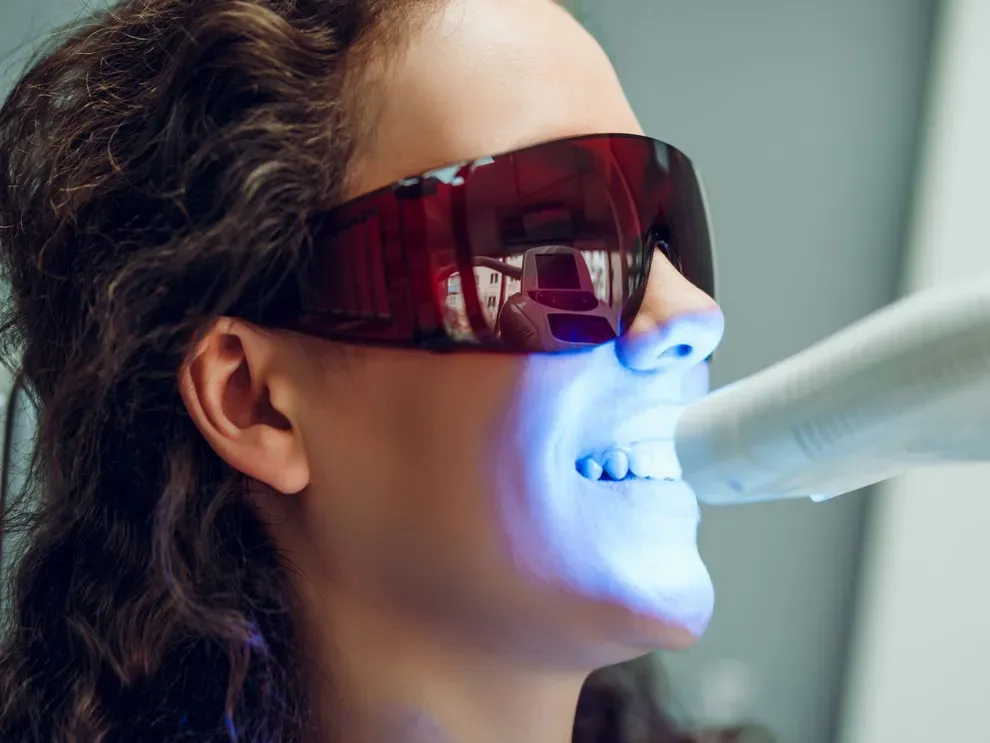Does LED Teeth Whitening Work?

Table of Contents
- What Are LED Whitening Kits?
- How It Works
- At-Home Whitening Candidate
- References
The science shows that LED teeth whitening does work.
Almost all of us want to improve something about our smiles, but we don’t want to go all the way to the dentist for something that might be simple. One of the most in-demand dental services is tooth whitening. But getting teeth whitening done at the dentist’s office can be expensive, time-consuming, and even uncomfortable.
Fortunately, an explosion of at-home whitening kits with LED enhancers have hit the market in the last few years, giving you dozens of options for high-quality, affordable, easy-to-use, and quick whitening treatments.
Previously, at-home whitening treatments were mostly strips that you left on your teeth, which could hurt sensitive teeth and gums, and thin enamel to a dangerous level. Modern kits require that much less gel or serum be applied to your teeth. They use a special type of LED (light-emitting diode) light to activate the product so it can brighten your teeth without soaking in deep and potentially causing damage.
Keep reading to learn how these kits work.
What Are LED Whitening Kits?
Most at-home whitening kits come with a few items, like:
Applicators that contain a special serum or gel that should be applied evenly to your teeth once or twice per day.
An LED that will activate ingredients in the serum or gel.
A mouthguard for the gel or to hold the LED close to your teeth, without using your hands.
Gradients so you can compare the original color of your teeth to their brightness as you progress in the treatment plan.
Although these are some basic items found in most at-home whitening kits, each one requires a slightly different approach. For some, you apply a small amount of the serum in the applicator. Others require you to apply most or all of it.
Some kits have enough product for a week of treatments. You will then need to pick treatments back up in two to four weeks. Other kits require you to treat your teeth for 20 days or more, but the brightness of your smile lasts for months.
With so many different details in each kit, can these LED treatments truly work? Is the LED required, or can you just use the whitening product alone?
Some kits require you to leave the gel and LED mouthguard in place for less than 10 minutes, while others require you to use it for up to 30 minutes per day.
How Can This Possibly Work?
Online customer reviews are often satisfactory, raving about the success of whitening kits. Not every review is good though. Of course, not everyone can be satisfied with every product, so how do you know which to choose, or if LED whitening kits are even worth it at all?
A study completed in 2012 comparing in-office whitening to a home-based kit found that peroxide-based whitening kits with an LED component that activated the product would lighten teeth. The most whitening occurred in the first two weeks of treatment, with little thinning of enamel that makes teeth and gums feel more sensitive.
People with average staining — usually from coffee, soda, wine, soy sauce, and related foods and drinks — were the best candidates. Anyone with higher levels of tooth staining, perhaps associated with other oral health issues, did best when they went to their dentist for cleaning and other treatment.
While this early study did side with in-office treatment over at-home treatment, technology has advanced rapidly in the last few years, increasing access to these at-home kits. Companies offer more affordable products, great promotions, fast shipping, and simple kits.
Many of these kits are safer too, so you do not have to worry about triggering tooth and gum sensitivity. The LED kit does, in fact, activate the peroxide product in the whitening serum, making it more effective. While you can use the gels and serums in at-home whitening kits by themselves (and some companies will include extra whitening applicators just for this purpose), you will get better, faster results when you add the LED component.
Are You a Good Candidate for At-Home Whitening?
If you have significant discoloration because you drink a lot of coffee or wine, and you have no other underlying oral health concerns, you are a good candidate for an at-home whitening kit with an LED or “cold” light diode component. You have probably experienced frustration with other whitening options before, like whitening toothpastes or strips.
Kits with a safe amount of bleach can help you get the level of brightness you want, which you can then maintain with occasional treatments, charcoal or other whitening toothpastes, and regular dentist visits.
